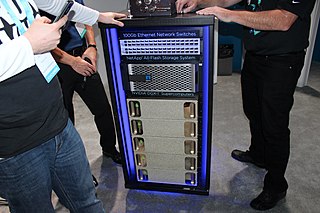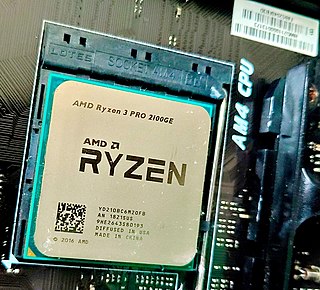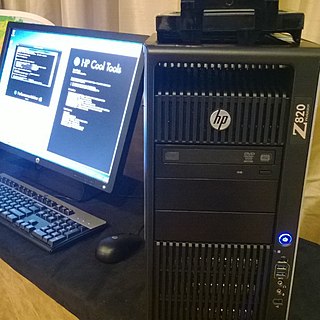Related Research Articles

Xeon is a brand of x86 microprocessors designed, manufactured, and marketed by Intel, targeted at the non-consumer workstation, server, and embedded markets. It was introduced in June 1998. Xeon processors are based on the same architecture as regular desktop-grade CPUs, but have advanced features such as support for error correction code (ECC) memory, higher core counts, more PCI Express lanes, support for larger amounts of RAM, larger cache memory and extra provision for enterprise-grade reliability, availability and serviceability (RAS) features responsible for handling hardware exceptions through the Machine Check Architecture (MCA). They are often capable of safely continuing execution where a normal processor cannot due to these extra RAS features, depending on the type and severity of the machine-check exception (MCE). Some also support multi-socket systems with two, four, or eight sockets through use of the Ultra Path Interconnect (UPI) bus, which replaced the older QuickPath Interconnect (QPI) bus.
In the fields of digital electronics and computer hardware, multi-channel memory architecture is a technology that increases the data transfer rate between the DRAM memory and the memory controller by adding more channels of communication between them. Theoretically, this multiplies the data rate by exactly the number of channels present. Dual-channel memory employs two channels. The technique goes back as far as the 1960s having been used in IBM System/360 Model 91 and in CDC 6600.

Intel Core is a line of multi-core central processing units (CPUs) for midrange, embedded, workstation, high-end and enthusiast computer markets marketed by Intel Corporation. These processors displaced the existing mid- to high-end Pentium processors at the time of their introduction, moving the Pentium to the entry level. Identical or more capable versions of Core processors are also sold as Xeon processors for the server and workstation markets.

Skylake is Intel's codename for its sixth generation Core microprocessor family that was launched on August 5, 2015, succeeding the Broadwell microarchitecture. Skylake is a microarchitecture redesign using the same 14 nm manufacturing process technology as its predecessor, serving as a tock in Intel's tick–tock manufacturing and design model. According to Intel, the redesign brings greater CPU and GPU performance and reduced power consumption. Skylake CPUs share their microarchitecture with Kaby Lake, Coffee Lake, Whiskey Lake, and Comet Lake CPUs.
Ice Lake is Intel's codename for the 10th generation Intel Core mobile and 3rd generation Xeon Scalable server processors based on the Sunny Cove microarchitecture. Ice Lake represents an Architecture step in Intel's process–architecture–optimization model. Produced on the second generation of Intel's 10 nm process, 10 nm+, Ice Lake is Intel's second microarchitecture to be manufactured on the 10 nm process, following the limited launch of Cannon Lake in 2018. However, Intel altered their naming scheme in 2020 for the 10 nm process. In this new naming scheme, Ice Lake's manufacturing process is called simply 10 nm, without any appended pluses.

Nvidia DGX is a line of Nvidia-produced servers and workstations which specialize in using GPGPU to accelerate deep learning applications. The typical design of a DGX system is based upon a rackmount chassis with motherboard that carries high performance x86 server CPUs. The main component of a DGX system is a set of 4 to 8 Nvidia Tesla GPU modules on an independent system board. DGX systems have large heatsinks and powerful fans to adequately cool thousands of watts of thermal output. The GPU modules are typically integrated into the system using a version of the SXM socket or by a PCIe x16 slot.

Ryzen is a brand of multi-core x86-64 microprocessors designed and marketed by Advanced Micro Devices (AMD) for desktop, mobile, server, and embedded platforms based on the Zen microarchitecture. It consists of central processing units (CPUs) marketed for mainstream, enthusiast, server, and workstation segments and accelerated processing units (APUs) marketed for mainstream and entry-level segments and embedded systems applications.

Epyc is a brand of multi-core x86-64 microprocessors designed and sold by AMD, based on the company's Zen microarchitecture. Introduced in June 2017, they are specifically targeted for the server and embedded system markets.

Zen 4 is the codename for a CPU microarchitecture designed by AMD, released on September 27, 2022. It is the successor to Zen 3 and uses TSMC's N6 process for I/O dies, and N5 process for CPU dies. Zen 4 powers Ryzen 7000 mainstream desktop processors and Ryzen 8000G series mainstream desktop APUs. It is also used in high-end mobile processors, thin & light mobile processors, as well as EPYC 8004/9004 server processors.

Ampere Computing LLC is an American fabless semiconductor company based in Santa Clara, California that develops processors for servers operating in large scale environments. Ampere also has offices in: Portland, Oregon; Taipei, Taiwan; Raleigh, North Carolina; Bangalore, India; Warsaw, Poland; and Ho Chi Minh City, Vietnam.

HP Z is a series of professional workstation computers developed by Hewlett-Packard. The first-generation desktop products were announced in March 2009, replacing the HP 9000 xw series. The product line expanded to mobile with the announcement of ZBook in September 2013, replacing HP's EliteBook W-series mobile workstations. The Z workstations mainly compete against Dell's Precision workstations, Lenovo's ThinkStation and ThinkPad P series workstations, as well as Apple's Mac Pro and MacBook Pro.

Alder Lake is Intel's codename for the 12th generation of Intel Core processors based on a hybrid architecture utilizing Golden Cove performance cores and Gracemont efficient cores. It is fabricated using Intel's Intel 7 process, previously referred to as Intel 10 nm Enhanced SuperFin (10ESF). The 10ESF has a 10%-15% boost in performance over the 10SF used in the mobile Tiger Lake processors. Intel officially announced 12th Gen Intel Core CPUs on October 27, 2021, mobile CPUs and non-K series desktop CPUs on January 4, 2022, Alder Lake-P and -U series on February 23, 2022, and Alder Lake-HX series on May 10, 2022.
Advanced Matrix Extensions (AMX), also known as Intel Advanced Matrix Extensions, are extensions to the x86 instruction set architecture (ISA) for microprocessors from Intel designed to work on matrices to accelerate artificial intelligence (AI) and machine learning (ML) workloads.

Golden Cove is a codename for a CPU microarchitecture developed by Intel and released in November 2021. It succeeds four microarchitectures: Sunny Cove, Skylake, Willow Cove, and Cypress Cove. It is fabricated using Intel's Intel 7 process node, previously referred to as 10 nm Enhanced SuperFin (10ESF).
Emerald Rapids is a codename for Intel's fifth generation Xeon Scalable server processors based on the Intel 7 node. Emerald Rapids CPUs are designed for data centers; the roughly contemporary Raptor Lake is intended for desktop and mobile usage. Nevine Nassif is a chief engineer for this generation.
Sierra Forest is a codename for Intel's first generation E-core based Xeon server processors. It is fabricated using Intel's Intel 3 process and compatible with the LGA 7529 socket.
Raptor Lake is Intel's codename for the 13th and 14th generations of Intel Core processors based on a hybrid architecture, utilizing Raptor Cove performance cores and Gracemont efficient cores. Like Alder Lake, Raptor Lake is fabricated using Intel's Intel 7 process. Raptor Lake features up to 24 cores and 32 threads and is socket compatible with Alder Lake systems. Like earlier generations, Raptor Lake processors also need accompanying chipsets.
LGA 4677 is a zero insertion force flip-chip land grid array (LGA) CPU socket designed by Intel, compatible with Sapphire Rapids server and workstation processors, which was released in January 2023.
LGA 7529 is an upcoming zero insertion force flip-chip land grid array (LGA) socket designed by Intel that will be used by the future Sierra Forest, a line of E-Core Xeon processors designed for heavily multithreaded cloud workloads, and Granite Rapids, the all P-Core mainstream Xeon microprocessors. The socket is also expected to support the mainstream successor to Granite Rapids, Diamond Rapids. The first pictures of the Intel 'Birch Stream' platform, a two socket engineering motherboard featuring dual LGA 7529 sockets, was posted on January 31, 2023, by Yuuki_Ans.
References
- ↑ Cutress, Ian (August 13, 2020). "Intel's 11th Gen Core Tiger Lake SoC Detailed: SuperFin, Willow Cove and Xe-LP". AnandTech. Retrieved August 20, 2020.
- ↑ Mujtaba, Hassan (October 14, 2019). "Intel Sapphire Rapids & Granite Rapids Xeons Are LGA 4677 Compatible". Wccftech. Retrieved March 14, 2020.
- ↑ Cutress, Ian (February 17, 2022). "Intel Discloses Multi-Generation Xeon Scalable Roadmap: New E-Core Only Xeons in 2024". AnandTech. Retrieved February 17, 2022.
- ↑ Shilov, Anton (October 27, 2020). "Intel: Alder Lake Sampling, Sapphire Rapids Samples in Q4". Tom's Hardware. Retrieved November 10, 2022.
- ↑ Mujtaba, Hassan (May 21, 2019). "Intel Xeon Roadmap Leak, 10nm Ice Lake, Sapphire Rapids CPU Detailed". Wccftech. Retrieved March 14, 2020.
- ↑ Alcorn, Paul (June 29, 2021). "Intel's Sapphire Rapids Roadmap Slips: Enters Production in 2022". Tom's Hardware. Retrieved June 30, 2021.
- ↑ Russell, John (November 17, 2019). "Intel Debuts New GPU – Ponte Vecchio – and Outlines Aspirations for oneAPI". HPC Wire. Retrieved November 18, 2019.
- 1 2 Patel, Nilay (October 4, 2022). "Pat Gelsinger came back to turn Intel around — here's how it's going". The Verge. Retrieved November 10, 2022.
- ↑ Schor, David (May 21, 2019). "Leaked Intel Server Roadmap Shows Sapphire Rapids With DDR5/PCIe 5.0 For 2021, Granite Rapids For 2022". WikiChip Fuse. Retrieved November 29, 2022.
- ↑ Mujtaba, Hassan (May 21, 2019). "Intel Xeon Roadmap Leaked Out, Unveils 10nm Ice Lake-SP With PCIe Gen 4 & Up To 26 Cores in 2020, Next-Gen Sapphire Rapids With PCIe Gen 5 & DDR5 in 2021". Wccftech. Retrieved November 29, 2022.
- ↑ Intel Technology (August 19, 2021). "Sapphire Rapids – Architecture Day 2021 | Intel Technology". YouTube. Retrieved November 29, 2022.
- ↑ Wheatley, Mike (November 1, 2022). "Intel's Sapphire Rapids server chips face yet more delays, with AMD set to benefit". Silicon Angle. Retrieved November 19, 2022.
- ↑ Cutress, Ian (June 29, 2021). "Update on Intel Sapphire Rapids in 2022: Q1 for Production, Q2 for Ramp, H1 Launch". AnandTech. Retrieved November 10, 2022.
- ↑ Cunningham, Andrew (November 2, 2022). "Intel's oft-delayed "Sapphire Rapids" Xeon CPUs are finally coming in early 2023". Ars Technica. Retrieved November 10, 2022.
- ↑ Shilov, Anton (November 2, 2022). "Intel's Sapphire Rapids Formal Launch Date Revealed". Tom's Hardware. Retrieved November 10, 2022.
- ↑ "Intel Launches New Xeon Workstation Processors – the Ultimate..." Intel. Retrieved February 17, 2023.
- ↑ "Crafting and Testing the Do-Anything Server Chip". Intel. February 7, 2023. Retrieved April 2, 2023.
- ↑ "4th Gen Intel Xeon Sprints into the Market". Intel. Retrieved April 2, 2023.
- ↑ Intel Corporation, Intel Unveils Future-Generation Xeon with Robust Performance and Efficiency Architectures
- 1 2 3 4 Cutress, Ian (August 31, 2021). "Intel Xeon Sapphire Rapids: How To Go Monolithic with Tiles". AnandTech. Retrieved November 10, 2022.
- ↑ "Intel® AVX512-FP16 Architecture Specification, June 2021, Revision 1.0, Ref. 347407-001US" (PDF). Intel. June 30, 2021. Retrieved July 4, 2021.
- ↑ "Intel® Architecture Instruction Set Extensions and Future Features Programming Reference" (PDF). Intel. May 2021. Retrieved November 10, 2022.
- ↑ Shah, Agam (April 25, 2023). "Intel's TDX Goes Through the Grind Ahead of Mass Release to Cloud". EnterpriseAI. Retrieved May 29, 2023.
- ↑ Larabel, Michael (December 16, 2022). "Intel IFS Ready To Weed Out Faulty Silicon With Linux 6.2". Phoronix. Retrieved January 13, 2023.
- ↑ Jiang, Dave (November 20, 2019). "Introducing the Intel® Data Streaming Accelerator (Intel® DSA)". 01 Intel Open Source. Retrieved November 10, 2022.
- 1 2 3 4 5 Larabel, Michael (January 13, 2023). "Setting Up Intel 4th Gen Xeon Scalable "Sapphire Rapids" For Accelerator Use". Phoronix. Retrieved January 13, 2023.
- ↑ Larabel, Michael (November 23, 2022). "Intel Details The Accelerators & Security Features For On Demand / Software Defined Silicon". Phoronix. Retrieved January 13, 2023.
- 1 2 Shilov, Anton (December 30, 2020). "Intel Confirms On-Package HBM Memory Support for Sapphire Rapids". Tom's Hardware. Retrieved January 1, 2021.
- ↑ Cutress, Ian (November 15, 2021). "Intel: Sapphire Rapids With 64 GB of HBM2e, Ponte Vecchio with 408 MB L2 Cache". AnandTech. Retrieved November 10, 2022.
- ↑ Tyson, Mark (August 19, 2021). "Intel Sapphire Rapids utillises tiled, modular SoC architecture". Hexus. Retrieved November 19, 2022.
- ↑ "Intel "Sapphire Rapids" Xeon 4-tile MCM Annotated". TechPowerUp. February 21, 2022. Retrieved November 19, 2022.
- ↑ Kennedy, Patrick (February 15, 2023). "New Workstation Kingpins Intel Xeon W-3400 Xeon W-2400 and W790 Launch". ServeTheHome.
- ↑ Robinson, Cliff (October 6, 2022). "Intel Xeon Sapphire Rapids to Scale to 4 and 8 Sockets". ServeTheHome. Retrieved November 27, 2022.
- ↑ "Intel 4th Gen Xeon Scalable "Sapphire Rapids" Server Processors Launch in January". TechPowerUp. November 2, 2022. Retrieved November 27, 2022.
- ↑ "Intel Xeon Scalable Processor Reference for Lenovo ThinkSystem Servers". Lenovo Press. Lenovo. January 19, 2024. Retrieved February 23, 2024.
- ↑ Liu, Zhiye (July 23, 2022). "Intel Sapphire Rapids Workstation Specs Leaked: Up To 56 Cores, 350W TDP". Tom's Hardware. Retrieved November 24, 2022.
- ↑ Mujtaba, Hassan (July 23, 2022). "Intel Sapphire Rapids-WS Xeon Workstation CPU Lineup Specs Leaked: Xeon W9 Up To 56 Cores, Xeon W7 Up To 28 Cores, Xeon W5 Up To 16 Cores". Wccftech. Retrieved November 24, 2022.
- ↑ "Intel Launches New Xeon Workstation Processors – the Ultimate Solution for Professionals". Intel. Retrieved February 16, 2023.
- ↑ Chiappetta, Marco (February 16, 2023). "New Intel Xeon W Processors Offer Massive Performance Boosts For High-End Desktops And Workstations". Forbes. Retrieved February 16, 2023.
- ↑ Alcorn, Paul (February 15, 2023). "Intel Launches Overclockable Xeon W CPUs up to 56 Cores: a Return to HEDT-Class Chips". Tom's Hardware. Retrieved February 16, 2023.